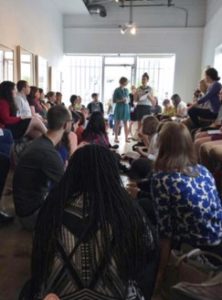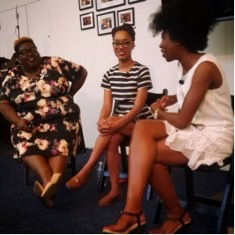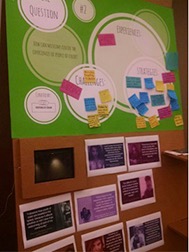Reflections from AAM 2016: Power, Influence, and Responsibility
Last year, attendees of the American Alliance of Museums’ Annual Meeting in Atlanta were pondering the theme of The Social Value of Museums the same weekend as the Baltimore Uprising, a series of city-wide protests in response to the police brutality that led to the death of Freddie Gray.
During last year’s meeting I heard many of my fellow attendees express their frustration that the conference barely acknowledged the Uprising was happening. It was only outside the conference walls where we could find the conversations we craved.
 The two most influential conversations I witnessed last year were not a part of the official AAM program: a Museums Respond to Ferguson conversation about museums and the Black Lives Matter movement and the first meeting of Museum Workers Speak, a group of activists urging museums to apply their social justice mission statements to their labor practice. The saving grace of the official conference program was keynote speaker Dr. Johnnetta Betsch Cole who did not shy away from challenging museums to examine their own privilege and to strive toward more intersectional practice.
The two most influential conversations I witnessed last year were not a part of the official AAM program: a Museums Respond to Ferguson conversation about museums and the Black Lives Matter movement and the first meeting of Museum Workers Speak, a group of activists urging museums to apply their social justice mission statements to their labor practice. The saving grace of the official conference program was keynote speaker Dr. Johnnetta Betsch Cole who did not shy away from challenging museums to examine their own privilege and to strive toward more intersectional practice.
This year the Annual Meeting was in DC, just 40 miles away from where the Uprising occurred and though the words of Dr. Cole inspired this year’s Annual Meeting theme of Power, Influence and Responsibility, the voices of many other museum professionals who continue to lead the way in social justice museum work remained sidelined.
Power
American museums are valued, trusted, and funded by the public and the government. Museums as institutions are also part of a legacy of white supremacy, colonialism, and imperialism. In this way, museums operate within a privileged dominant group. The power inherent in that position gives museums the opportunity to be an ally to those who are not part of the privileged dominant group.
In the social justice world an ally is defined as a person in a dominant group who actively supports people who are being discriminated against and works to eliminate prejudice.
Many of the sessions at the Annual Meeting focused on visitors with marginalized cultural identity markers including people of color, queer individuals, and women. But it was the work of a handful of individuals and organizations who took those conversations to a level of true allyship, with intersectional analysis and critique, much of it not included in the AAM program.
Influence
The conversations that were the most influential to me and my conference experience were led by the Empathetic Museum, Museum Workers Speak, the Center for the Future of Museums, Museum Hue, the Incluseum, and Crosslines. This social justice programming was what made my conference experience so valuable and it’s clear from articles like this one that attendees who did not seek it out were at a different conference than the one I was attending.

The Empathetic Museum, together with the Museum Group and Museum Workers Speak, organized Museums & Race: Transformation and Justice, a half-day workshop to discuss and challenge systemic oppression in museums. The workshop was not affiliated with the conference and was held offsite. Museum Workers Speak went from holding a single rogue session at last year’s conference to being involved throughout this year’s conference, with an
official conference session, a breakfast, and a discussion at the Center for the Future of Museum’s (CFM) Demo on Museums and Labor. The CFM also worked with the Incluseum to facilitate an activity about bias in museums and Museum Hue to host discussions about hiring practices and inclusion. Attendees who ventured down to the National Mall to visit Crosslines: A Culture Lab on Intersectionality, experienced an inspirational suite of art exhibitions and performances from over forty artists and scholars of color, curated by the Smithsonian Asian Pacific American Center.
This is the kind of work that makes me excited to be a museum professional. By choosing a conference theme that explores power, influence and responsibility, AAM seems excited about this work too. I would love to see AAM support the leaders championing these conversations by providing future platforms and a continued commitment to conference themes that center social justice.
Responsibility
Museum professionals are hungry for a greater variety of voices and perspectives. This year’s lineup of keynote speakers was particularly male and particularly white. One of the simplest ways museums can do the work of allyship is to lift up marginalized voices.
 Attendees are urging the Annual Meeting to take a more intersectional approach. For example: no all-white panels, make all-gender restrooms available, provide personal pronouns on our name tags, and include ASL interpretation. As AAM attendees we must ask ourselves: why is it that these important conversations are happening outside of the conference? And it’s important for all Annual Meeting attendees to acknowledge that we are not starting the conversations we have at the conference, we are continuing them. We can honor those who came before us by researching their work, citing them, and whenever possible, sharing the podium.
Attendees are urging the Annual Meeting to take a more intersectional approach. For example: no all-white panels, make all-gender restrooms available, provide personal pronouns on our name tags, and include ASL interpretation. As AAM attendees we must ask ourselves: why is it that these important conversations are happening outside of the conference? And it’s important for all Annual Meeting attendees to acknowledge that we are not starting the conversations we have at the conference, we are continuing them. We can honor those who came before us by researching their work, citing them, and whenever possible, sharing the podium.
The AAM Annual Meeting is an opportunity for us as museum professionals to expand our spheres of influence. We must continue to learn from one another and hold one another accountable.
Margaret Middleton is an independent exhibit designer and museum consultant in New England interested in the intersection of design and social justice. Margaret is also a queer activist and advocate for family-inclusive museum practice. You may have seen Margaret’s Family Inclusive Language chart in Museum magazine.
Photo captions and credits from top to bottom: (1) Stephanie Cunningham, co-founder of Museum Hue, speaks at the Center for the Future of Museum’s Demo on Museums and Labor. Photo courtesy of AAM. (2) The packed room at Museum Workers Speak’s rogue session during AAM2015. Photo courtesy of Miriam Bader. (3) Adrianne Russell and Aleia Brown of #MuseumsRespondtoFerguson interview curator Camille Bethune-Brown (center) at Crosslines. (4) One of the discussion boards at the Museums & Race workshop, curated by Visitors of Color.

